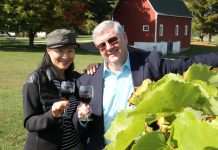
Sean O’Keefe is the winemaker at Mari Vineyards on the Old Mission Peninsula near Traverse City. Growing up as part of Michigan’s “First Family of Riesling” — Chateau Grand Traverse founder Ed O’Keefe Jr. is his dad — he went on to study and learn to develop his Riesling-making skills in Germany. At Mari, he specializes in making Rieslings and Italian wines using grapes that include many not typically grown in Michigan before.
With Amanda Danielson (of Trattoria Stella/The Franklin in Traverse City), O’Keefe launched a City of Riesling event in Traverse City that brings Riesling makers and fans from all over together. The fifth City of Riesling will be held in June 2020.
Most recently, O’Keefe was invited to the Finger Lakes region of New York to conduct a master class in Riesling on behalf of the Finger Lakes Wine Alliance. Here, he talks about his affinity for Riesling and the importance of U.S. Riesling regions sticking together.
Michigan Wine: Why Riesling?
O’Keefe: What I love about it is it tastes of where it comes from like no other grape. It doesn’t stand much manipulation by winemakers. It’s really beautiful in its simplicity, but to make a really beautiful, simple wine is one of the hardest things in the world — trying to balance acidity and fruitiness and all the flavors that come from the season and the vintage.
What did you do on your recent visit to the Finger Lakes?
The Finger Lakes Wine Alliance invited me to teach a master class with wine critic David Schildknecht, who is legendary for his erudition in our world. We both had a budget to pick six or seven wines that we consider the most interesting and distinctive Rieslings in the world, to get the Finger Lakes winemakers there to think outside their bubble. I brought Rieslings from Western Australia, Austria, Germany, parts of Oregon and of course, Michigan. Riesling doesn’t have to be a pandering sweet dessert wine, and it doesn’t have to be a shrill dry wine. There are all kinds of things you can do.
How does Michigan Riesling production compare to other U.S. regions?
I consider Old Mission and Leelanau the northwest frontier of the Great Lakes region (that also includes the Niagara Peninsula of Ontario and the Finger Lakes of New York). We’re a unique maritime climate sitting directly on the edge of the much harsher continental climate of the Midwest. The water surrounding us moderates the extremes of cold and heat, and allows us to grow primarily vinifera wine varieties such as Riesling. Nevertheless, we still have to deal with pretty significant swings in weather from year to year. One saving grace is our sandy glacial soils which are very well drained, and prevent the winter kill you might find in areas with more clay. These lighter soils lend our wines a delicacy of aroma and flavor that require a light touch in the cellar in order to not overwhelm them.
Why do Riesling makers need to stick together?
Riesling makers across the country are a pretty tight group and we all know each other. We’re going up against Chardonnay and Cab — everything that is marketed heavily — so it’s better to have all the people passionate about it meet every now and then, exchange ideas, share our stories with the rest of the world, and before you know it, start building momentum and keep the enthusiasm going.
At Mari, you’ve been building the repertoire of Italian wines. How is that going?
The name Mari itself comes from (Mari owner) Marty Lagina’s grandmother’s maiden name. Her family emigrated from northeastern Italy. The Lagina family wanted to explore this historical connection and luckily our climates overlap enough that we can grow many of the same wine varieties here, both white and red.











Facebook Comments